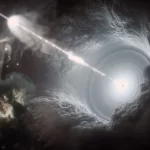Key Takeaways:
- Astronomers have captured a groundbreaking image of the ‘monster galaxy’ COSMOS-AzTEC-1, situated a staggering 12 billion light years from Earth.
- This celestial behemoth produces new stars at a rate nearly 1,000 times faster than our Milky Way.
- Observations were made using the cutting-edge £1.1 billion ALMA Observatory in Chile, providing a resolution tenfold higher than previous attempts.
- The galaxy’s structure, including two distinct large clouds thousands of light-years from its center, unveils previously unknown details.
- COSMOS-AzTEC-1’s unprecedented size and instability challenge conventional understandings of galactic formation.
In a cosmic revelation that underscores the insignificance of our terrestrial existence, a team of astronomers has unveiled an awe-inspiring image of a galaxy located a staggering 12 billion light years away. This colossal entity, aptly dubbed ‘COSMOS-AzTEC-1’, surpasses our own Milky Way in star production by a factor of approximately 1,000. The revelation was made possible through the deployment of the £1.1 billion ALMA Observatory in Chile, which achieved an astounding tenfold increase in observational resolution compared to prior endeavors. This feat has bestowed upon scientists unprecedented insights into the structure of this ‘starburst’ galaxy, believed to have taken form within the initial billion years following the big bang.

Ken-ichi Tadaki, from the National Astronomical Observatory in Tokyo, Japan, which collaborated with the University of Massachusetts Amherst in this endeavor, articulated the groundbreaking discovery, stating, “We found that there are two distinct large clouds several thousand light-years away from the center.”
This revelation stands in stark contrast to the Milky Way, which possesses a singular, dense core with spiral arms extending outwards. In a remarkable departure from the norm, COSMOS-AzTEC-1 exhibits three cores, or rather, two smaller cores, each with its own accompanying discs, located many light years away from the central core. This aberration raises intriguing questions about the galaxy’s formation and evolutionary trajectory.

Furthermore, this mammoth galaxy displays an unexpected degree of instability. The colossal mass of gas surrounding it exerts an overwhelming pressure on the core, overwhelming the compensatory outward spin. Unlike conventional galaxies where the inward gravitational force balances the outward pressure, this anomaly is undergoing a colossal gravitational collapse, a phenomenon likely driving its rapid star formation. Astonishingly, the researchers project that the entire galaxy will implode entirely within approximately 100 million years. Yet, the origins of this cosmic giant remain a perplexing enigma, prompting scientists to delve deeper into the mysteries of galactic evolution.


